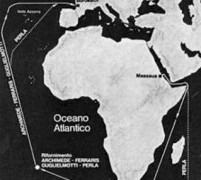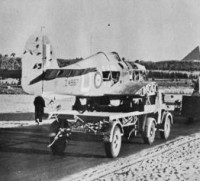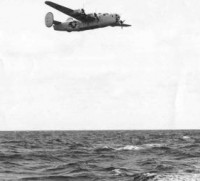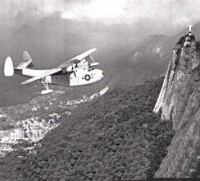- COMMANDER SOUTH ATLANTIC
23)OPERATIONS MAY 1943
For May, the first noteworthy event was a fire. This occurred the second of the month aboard the Livingston Roe, a War Shipping Board operated Tanker, then tied up in the harbor of Recife. A dockside locomotive passed close to the ship, and a spark from its stack came accidentally into contact with loose gasoline, which had leaked from a broken fueling hose. From the Livingston Roe flames spread rapidly to Armazem number 2, in which various U. S. Army stores had accumulated. Ships tied close to the fire had to stand out of the harbor. These were the Humboldt and the Milwaukee, both of which temporarily proceeded to sea. The Livingston Roe finally had to be towed from her berth and beached at the north end of the harbor. Fire fighters extinguished the conflagration at the Armazem late in the afternoon, and put out the ship's fire in the early hours of the next morning.
Personnel from U. S. and British vessels in the harbor, from both Army and Navy shore establishments, and from Brazilian military and civil organizations, all worked on the fire, which in spite of its seriousness never got out of hand. Since the Livingston Roe was loaded with 100 octane gasoline, and the neighboring warehouses contained both ammunition and dynamite, a major catastrophe had been narrowly averted, thanks to effort and cooperation and some good fortune. A little more and all neighboring shore establishments would have been blazing. The submarine war grew bitterer during the course of May, and "Alerts" twice had to be established on the Brazilian coast; once from Recife to Vitoria, and later from Natal to São Luiz. Subs were constantly in the South Atlantic during the month and the Fleet kept hotly after them.
On the 8th, the Moffett and Winslow, later joined by the Barry, stood out of Recife to hunt a sub that had attacked unsuccessfully a member of a Trinidad-Bahia Convoy. Planes of Fleet Air Wing Sixteen and the FAB gave assistance. When contact was made, a Brazilian plane delivered an attack on the U-Boat. No results could be observed other than air bubbles on the surface. This search nevertheless continued the entire day and into the night. The following morning a Navy plane discovered a submarine, possibly a different one, somewhat farther north. The ships, one by one, were ordered to abandon the region of their original search and shift to this new scent. It is disappointing to relate that no attacks resulted, since no contacts could be made with the enemy.
However, a little over a week later, the Fleet did "kill" a sub. This one was reported on the 16th, when in the early afternoon, a VP-74 plane sighted a U-Boat conning tower and wake at 10° 58' S, 35° 59' W. It released a stick of mark 44 depth charges, 65 seconds after the conning tower disappeared. Three of the charges appeared to be duds, and no signs of damage to the sub appeared. The Moffett and Jouett were ordered to the scene of the attack, and in the meantime VP-74 carried out standard "hold-down" procedure.
The night passed, and at 0915 in the morning a seaplane found the marauder surfaced and immediately attacked. The damage inflicted proved sufficient to keep it from submerging. The Moffett and Jouett then moved in and finished the submarine with their guns. The position by this time was 11° 08' S, 35° 38' W. Forty -seven survivors were picked up by the two ships, and four dead Germans received burial at sea. The Moffett and Jouett thereupon proceeded to Recife with the prisoners. Some other good contacts resulted during the month, but in no case did a sub sinking follow.
On May 20, a transient plane received some damage by anti-aircraft fire form a submarine at 06° 20' S, 12° 40' W. Ascension Island sent out an Army bomber which located the sub, dropped depth charges, and saw it submerge. Oil slick was later reported in the vicinity; also three lifeboats with sails. But according to the rule generally followed, this did not justify claiming a kill.
The day following, the Siren, escorting a Bahia-Trinidad convoy, made a contact and attacked without results, in position 00° 35' S, 47° 20' W.
Meanwhile, the submarines continued to take their toll. They sank the steamer Samuel Jordan Kirkwood off Ascension Island, and a few days later, in the same vicinity, destroyed he Dutch Merchant Vessel Benekat. On the 28th they scored off a Bahia-Trinidad Convoy, in 03° 56' S, 36° 43' W. Three merchant ships received damage. One had to be towed and beached off Fortaleza. The other two were able to proceed with the rest of the convoy, at a slightly reduced speed. Three Brazilian warships came to the aid of the convoy, to assist both in towing operations and in anti-submarine sweeps in the area. All efforts to locate the submarine failed, there being no further sightings.
The only other damage was accidental, and occurred to two Cruisers of the Fleet. On the last day of the month, the Milwaukee and Omaha Sides wiped while proceeding from Montevideo to Recife and Rio respectively. The Omaha got the worst of the exchange and received some minor injury to her bow plating and stern. Arrangements had to be made for her to drydock in Rio, where these parts were worked over. No major damage resulted, however, and operation plans did not need to be altered as a result of the accident.
Hyper War. Commander South Atlantic Force. U.S Naval Administration in WW II.



